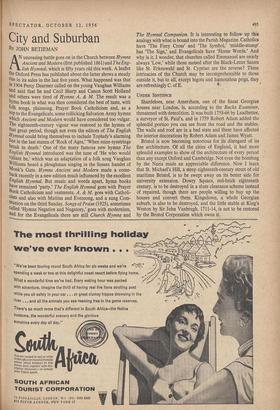City and Suburban
BY JOHN BETJEMAN N N unceasing battle goes on in the Church between Hymns Ancient and Modern (first published 1861) and The Eng- lish Hymnal, which is fifty years old this week. A leaflet the Oxford Press has published about the latter shows a steady rise in its sales in the last five years. What happened was that in 1904 Percy Dearmer called on the young Vaughan Williams and said that he and Cecil Sharp and Canon Scott Holland and others were tired of Hymns A. & M. The result was a hymn book in what was then considered the best of taste, with folk songs, plainsong, Prayer Book Catholicism and, as a sop to the Evangelicals, some rollicking Salvation Army hymns Which Ancient and Modern would have considered too vulgar. The eighteenth-century vigour was restored to the hymns of that great period, though not even the editors of The English llYmnaI could bring themselves tp include Toplady's alarming line in the last stanza of 'Rock of Ages,' When mine eyestrings break in death.' One of the many famous new hymns The English Hymnal introduced was the tune of `He who would valiant be,' which was an adaptation of a folk song Vaughan Williams heard a ploughman singing in the Sussex hamlet of Monk's Gate. Hymns Ancient and Modern made a come- back recently in a new edition much influenced by the excellent English Hymnal. But music and words apart, hymn books have remained `party.' The English Hymnal goes with Prayer 1300k Catholicism and vestments, A. & M. goes with Catholi- eisin and also with Mattins and Evensong, and a sung Com- munion on the third Sunday. Songs of Praise (1925), sometimes called `Hymns Negative and Nugatory,' goes with modernism, and for the Evangelicals there are still Church Hymns and The Hymnal Companion. It is interesting to follow up this analogy with what is bound into the Parish Magazine. Catholics have 'The Fiery Cross' and 'The Symbol,' middle-stump' has 'The Sign,' and Evangelicals have 'Home Words.' And why is it, I wonder, that churches called Emmanuel are nearly always `Low,' while those named after the Black-Letter Saints like St. Erkenwald and St. Cyprian are the reverse? These intricacies of the Church may be incomprehensible to those outside it, but to all, except bigots and humourless prigs, they are refreshingly C. of E.
UNDER SENTENCE Shardeloes, near Amersham, one of the finest Georgian houses near London, is, according to the Bucks Examiner, threatened with demolition. It was built 1758-66 by Leadbetter, a surveyor of St. Paul's, and in 1759 Robert Adam added the splendid ;portico you can see from the road and the stables. The walls and roof are in a bad state and these have affected the interior decorations by Robert Adam and James Wyatt.
Bristol is now becoming notorious for its disregard of its fine architecture. Of all the cities of England, it had more splendid examples to show of the architecture of every period than any except Oxford and Cambridge. Not even the bombing by the Nazis made an appreciable difference. Now I learn that St. Michael's Hill, a steep eighteenth-century street of old maritime Bristol, is to be swept away on its better side for university extension. Dowry Square, red-brick eighteenth century, is to be destroyed in a slum clearance scheme instead of repaired, though there are people willing to buy up the houses and convert them. Kingsdown, a whole Georgian suburb, is also to be destroyed, and the little stable at King's Weston by Sir John Vanbrugh, 1711-14, is not to be restored by the Bristol Corporation which owns it.










































 Previous page
Previous page